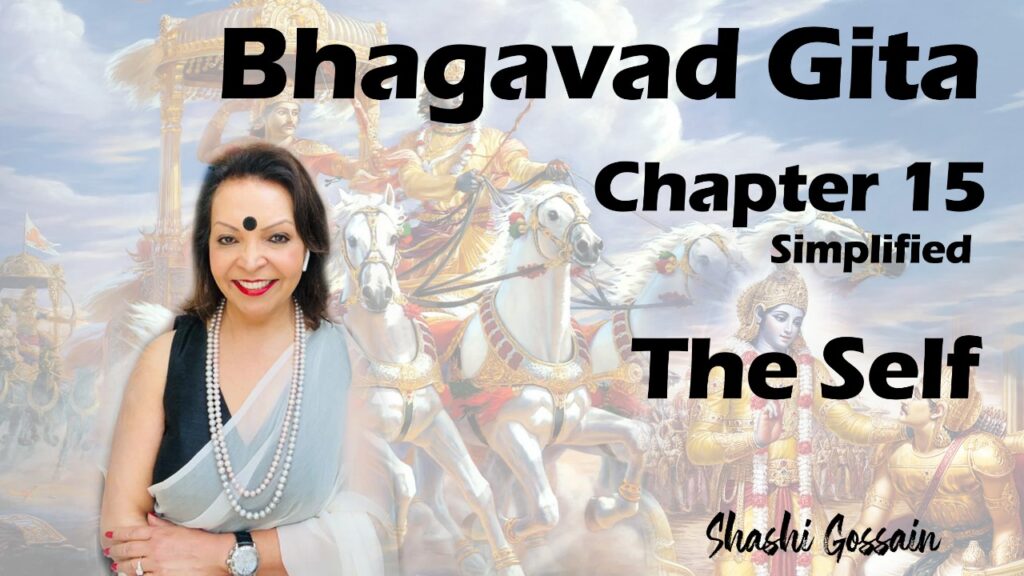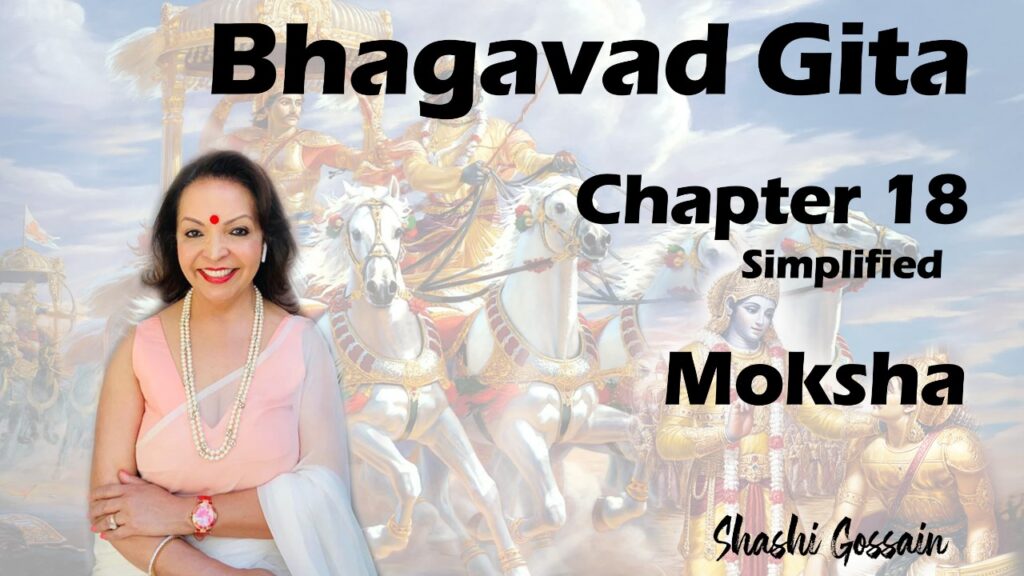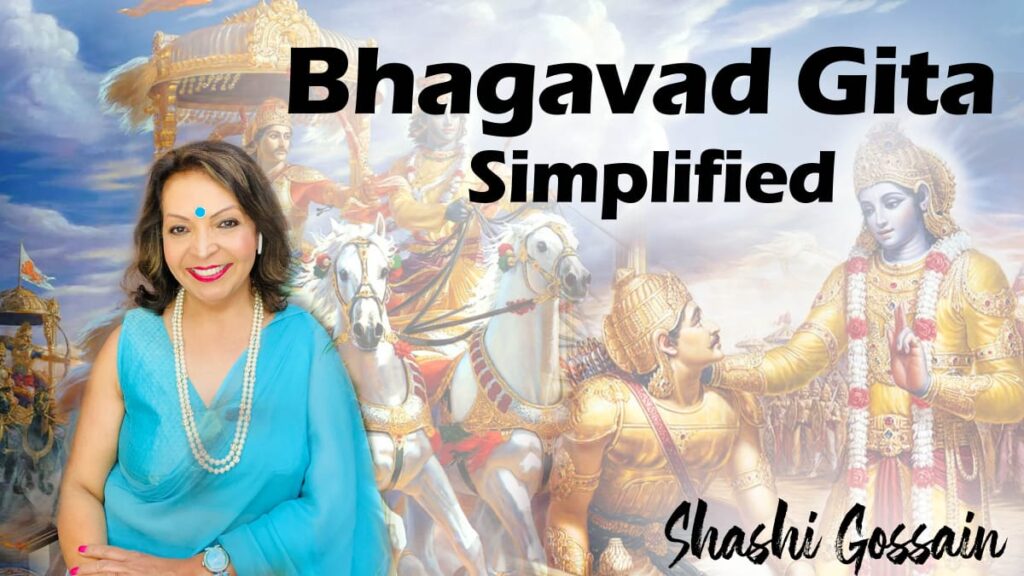The fifteenth chapter of the Bhagavad Gita is unique in several respects. It is the shortest, with only twenty shlokas. It summarizes the entire essence of not just the Gita but also all the Vedas. It covers four topics that are at the essence of any spiritual scripture:
- What is the world?
- Who am I?
- What is God?
- What is the relationship between me, the world and God?
Shri Krishna begins the fifteenth chapter describing an unusual sort of tree, similar to a tree’s reflection in water. It is upside down, with roots above and branches below. Also, these trees are never static. They keep changing. The farther away one goes from the root, the greater is the loss of the significance.
What does the Gita’s inverted tree metaphor signify
Now, let us examine the metaphors used in this illustration.
- The root of this tree is Ishvara, the brahman, the eternal essence with form.
- Its branches have evolved from Ishvara. They are the hardening of Prakriti, the hardening of the three gunas due to their combinations. It is termed as imperishable because in ignorance, it is permanent after a time. This is similar to a tender, subtle sapling hardening into a robust tree as it grows over time.
- The Vedas, represented as the leaves of the tree, are the rules of this universe. They give us clear instructions on how to act honourably & spiritually in life. The one, who knows how to get to the source which is Ishvara, needs to know nothing else. The upside-down tree is a metaphor for the material world. When its buds grow into branches and touch the ground, they turn into roots that embed firmly into the ground, and then grow into several additional trunks around the main tree, like in the Banyan tree family. Over a period of time, a small tree with one trunk becomes a mini forest in itself.
Our lives are no different. e.g. we dream to own a house. So first we take out a huge loan to buy a house. Then 2 cars to go in the garage, then, furniture, TV etc.. So the one purchase of a house led to other purchases, which led to other purchases and so on. This is nothing but the upside down tree of samsaara playing out in our lives. The tree of samsaara, made up of the three gunas of Prakriti, grows and expands through repetitive chasing of sense objects. Like this tree, this saṃsara is vast, many-branched, well-rooted and not easily destructible. The jīva is caught in this saṃsara, helplessly struggling to free itself. So,
why has Shri Krishna started talking about this tree now?
It is to cultivate dispassion or vairagya in us. Even a tinge of attachment to the world can derail our spiritual progress. Each sense object generates desires, desires generate actions to get those sense objects, and attainment of sense objects creates further desires. These bind us to the branches of the tree, going further away from Ishvara, who is at the root of the tree. Shri Krishna says that most of us do not have the big picture view of our existence in this world. E.g. a factory worker employed in a company only sees his machines 8 hours don’t know the whole complex company dealings. We too, simply live out our lives in the endless chain of attraction to sense objects, desire, action, result and further desire. To lift us out of this narrow view of life, he gave us the illustration of the tree of samsaara. He very clearly states that no matter who we are, whether rich or poor, educated or uneducated, we are all entangled in this upside down tree of samsaara. We never see our existence as it really is. It is in fact, a gigantic illusion that has been given reality due to the long standing ignorance of our true nature.
How can Moksha be achieved?
Shri Krishna says: All of you are lost in the cycle of action and reaction, the tree of samsaara. So take refuge in me. I am the original Purusha, the root from which this tree of samsaara has sprung up. I have created this universe. Don’t get lost in the branches of the tree which are fuelled by the three gunas of Prakriti. Come straight to the source, which is me. Hold my hand. I will save you from drowning in samsaara. When we have realised that we are entangled in our emotions, and genuinely want a solution, we have to overcome our pride or ego. We can cultivate dispassion by seeking & taking refuge in Ishvara. but We cannot have it both ways, We cannot love Ishvara and Love the material world at the same time. If we cannot control our mind and senses, we have yet to cultivate real devotion for Ishvara. The final liberation is achieved with Devotion andDispassion towards the world. Once achieved, we will not have to return back to the material world. Shri Krishna says, for the seekers who strive for Liberation, it’s a 2-step process:
- Reduction of “I” & “mine”, which is pride & delusion.
- Find out where is his attachments are stuck: e.g. profession, family.
Eventually, they will find they are: attached to their body, and the fear of death.
Attachments can be conquered through the control of the mind and senses. Only then can we focus on the main goal, which is daily absorption in the self, adhyaatma nitya. We have to be constantly vigilant of all opposites e.g. like/dislike, sorrow/joy. We should be able to observe them silently as they come and go. This will remove ignorance of the true nature of our self. We will then attain his abode. He says that there is no sun, no moon, no fire, in other words, no source of light in his abode. This symbolically means:
- Sun: our ego & intellect
- Moon: our mind and emotions
- Fire: our physiological functions
So, those who sought refuge in Ishvara automatically give up any importance to all sensory reactions, as they are the root of all our sorrows. Such a person will never again get caught in the cycle of samsaara & will be liberated. He will never return to ignorance. This is the abode of Ishvara. Shri Krishna then describes the state of the individual souls, or jeevas, who are stuck in the cycle of samsaara, of birth and death. The jeeva still harbours selfish desires. The mind, which contains the desires and five senses are still involved with prakriti. The jeeva, the mind & the senses is also called the subtle body because its invisible. Shri Krishna says there’s an eternal part of Ishvara which is present as the embodied-soul in every body. Upon death, just like the wind takes away the fragrances away from their sources, similarly the embodied-soul carries the mind and the senses with it and moves to another body, after leaving this body. It moves into a tiny, physical body, an embryo in a womb, based on the desires it wants to exhaust through the mind & senses. Shri Krishna emphasise that the wise one can distinguish that the jeeva is-
- Separate from the physical body, as well as
- The reason for its existence.
Most of us think that the “I” is our ego, when it is actually the eternal essence. Only those who have followed the path of ‘karma yoga’ and ‘bhakti yoga’ will be able to properly absorb any spiritual teachings. Only those with a pure mind and systematic study will truly understand the nature of the jeeva as the eternal essence, which has been limited by its upaadhis, or physical body.
How does God connect with us?
Shri Krishna now begins to explain his connection with the world around us. He says:
- The brilliance of the sun that lights up the entire world & consequently,
- The radiance of the moon &
- The fire has originated from me.
Symbolically, the sun represents our sensory organs e.g. the eyes, ears, nose and so on. Therefore, any living matter from a single-celled amoeba to a human being has awareness, a consciousness, which is the power of Ishvara at work. We can realize the connection of our nature with the world through the common link of awareness. Shri Krishna says that it is Ishvara that
- Enters the earth and
- Sustains every being, every atom in it through his force.
Just like there is a force holding our body together, there is a force that holds the earth as one entity. Isn’t it amazing that forces of gravity, electromagnetism, atomic forces, ecosystems & life cycles have been explained in our scriptures, long before the western scientists discovered it? We know energy requires a medium to travel from its source to its destination. In order to provide nourishment to all living beings, Ishvara resides in the form of nectar, the sap, the essence of all vegetation. A healthy plant-life in any ecosystem ensures the prosperity of animals, birds and humans that depend upon it. Ishvara is this sap; this essence within the plants that gives energy to all life also gives us energy. Moreover, many herbs have medicinal value in additional to their nutritional value, providing yet another layer of benefits to all animals and humans. In this manner, whether it is Energy, nourishment or healing. Ishvara is pulsating through us in the very same manner that he is pulsating through the world. So, Shri Krishna says that we are nourished by vegetation, and energy is released through the “digestive fire dwelling”, which represents the process of metabolism. This is supported by two forces, called-
- Praana: which brings food towards the digestive organs &
- Apaana vayus: excretes the non-essential food.
Shri Krishna refers to four types of food that convert into energy: Food that can be:
- chewed e.g. rice
- sucked e.g. lemons
- drunk e.g. fruit juices, and
- licked e.g. pickles
So we see that the production, distribution & the ultimate consumption of energy that happens in us, & all other living being, is nothing but Ishvara. Ishvara is the Producer, distributor and consumer. This is yet another example of our oneness with the world.
What does Bhagavad Gita say about knowledge?
We humans crave knowledge in all its forms, history, geography, sciences and the arts… Shri Krishna says that he is both the producer and consumer of knowledge in our lives. The sum total of all knowledge is referred to as the Vedas. The assimilation of knowledge goes through three steps.
- “apohanam” we do not know anything
- “jnyaanam” knowledge begins, & finally
- “smritihi” knowledge is stored in memory
All these steps towards the acquisition of knowledge happen due to Ishvara, who is seated in our intellect. The ultimate knowledge is one which reveals the true nature of the self and its identity with Ishvara. The conclusion, the anta of the Vedas. Therefore it is known as Vedanta. So whenever we learn something new, or we recall something from our memory, we should understand that Ishvara is functioning within us.
Is Purusha one or many?
Shri Krishna says there are two types of Purushas, or aspects of Ishvara in the world:
- Perishable: the visible world, with all living and inert beings. Physical bodies which born & die.
- Imperishable: The invisible entity called Maaya.
Who is called Purushottam? What is the meaning of purushotham?
The lord of the three worlds (heaven, earth and hell, or even our waking, dreaming and sleeping states) Shri Krishna reveals his true identity as Purushottama, the foremost person, the pure brahman without any limitations, or the eternal essence. He says he’s superior to the perishable Prakriti & imperishable embodied souls.
And Purushottama is the-
- the intelligence behind whole creation,
- the intelligence behind the creator and
- raw material behind the creation
The Upanishad compares Purushottama to a spider that weaves the web from within him, and eventually, pulls back the web into himself. He’s the creator & destroyer. Shri Krishna says you will know Purushottama when:
- we see our “I” as no different from anyone or anything else
- we do not pay attention to the name and form
- we see the self as the basis of all name and form
Worship of Ishvara as a deity with name and form is a small, but an essential step in the direction of realizing the Purushottama who is beyond all name and form. The most important knowledge we need is to understand three topics:
- Who am I?
- What is this world and where did it come from?
- What is beyond this world?
These answers are given in this chapter. The teaching of this chapter is called the foremost secret. It is secret because such knowledge is not accessible to any of these sense organs. Purushottama, the pure eternal essence, has to be revealed through a series of analogies to fully understand the relationship with us, the mortals. When we learn that the “I” in us is the “I” in everyone, the self of all, that’s the conclusion of one’s spiritual journey. This is the grand message of the Bhagavad Gita.



